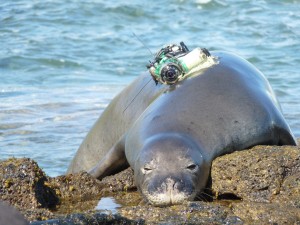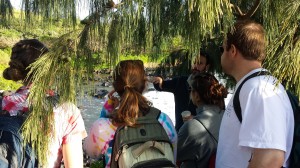Our last two days on Kauai were spent working with NOAAs Hawaiian Monk Seal Research Program. The goal was to deploy a suite of instruments on 1-2 monk seals over the course of the week. The instrument package includes a GPS phone tag that transmits the location of the seal through the GSM cell phone network, a National Geographic Crittercam that records video footage of the seal underwater, a 3-axis accelerometer, and a VHF radio transmitter. Everything but the GPS tag is recovered after 3-5 days.

One seal (RK05), an adult male, was tagged on Wednesday while we were meeting with Keith Robinson, so we spent the rest of the week helping the NOAA team search for candidate number two. Monk seal field work is different on every island; on Kauai it involves a LOT of driving and waiting. There are roughly 200 seals inhabiting the Main Hawaiian Islands and about 30-40 of those are regularly seen on Kauai. Of those, we were only looking for sub-adult or adult males, which reduces the abundance of potential candidates even further. Add to that, the amount of coastline on Kauai where a seal can haul-out (there is a lot) and you begin to imagine how difficult it might be to find multiple seals to tag in just a few days…and why we spend so much time in the car driving from beach to beach searching for animals.
Knowing how much time would be spent in the car, Charles Littnan, the head of the monk seal research program suggested we have a ‘mobile lecture series’ as we drove around looking for seals. The NOAA team and monk seal volunteers had already checked most of the southern beaches by the time they met up with us at 7 am Thursday morning. The large volunteer network on Kauai allows us to ‘check’ multiple beaches all within a short period of time and know where the seals are (or aren’t) all before 9 am. When we met the team, there was only one beach left to check so we all piled in the vans to head north. Charles went with one of our Duke vans, and the monk seal program veterinarian Michelle Barbieri went in the other. Michelle spent the morning explaining what her position is with the program, what the health and disease threats are for monk seals, what mitigation steps the program is looking into, how they decide which seals to translocate each year in the Northwestern Hawaiian Islands and which island/atoll they will be moved to/from. She also talked about other health and disease issues that environmental managers may need to deal with on the mainland and in Hawaii, including unusual mortality events. I can’t comment on what the other van discussed with Charles, but it likely included some commentary on NOAA science center and regional office interactions, the status and recovery of monk seals, and pop culture.

After weaving our way through some terrible traffic, we finally arrived at Donkey Beach to look for seals. We knew there was one seal on the main beach the day before, but he is in the process of molting and was therefore not a candidate for us. Charles led the group down the trail and around to an overlook so we could scan a smaller beach around the corner. While searching for seals through binoculars the group began wondering how Donkey Beach got it’s name. Charles informed us that there used to be a small town at the top of the hill and they would bring goods out to ships in the bay by loading up donkey’s and then swimming the donkeys out to the ships to be loaded. He was completely full of it and had absolutely no idea how it got it’s name. If you’re curious, beach’s official name is Paliku, but it was nicknamed Donkey Beach after the mules that were in a pasture nearby and used to haul sugar cane. Apparently there were never any Donkey’s near the beach, just mules…maybe those who came up with the nickname didn’t know the difference?

Back to the seals. There weren’t any of them. All of the beaches had been checked by then and there were no reports of catch-able seals anywhere. As the students wondered what we were going to do next and we were explaining that the only thing left to do was wait until later in the day to check all the beaches again, Charles’ phone started blowing up. The first call was about a potentially entangled seal on Kauai, the second was a call about an injured and potentially hooked seal on Niihau. Welcome to monk seal field work! The world can go from quiet to crazy in a matter of minutes. Instrument deployments were immediately suspended and Mark Sullivan, a staff researcher for the monk seal program, set off to find the Kauai seal. He determined that it wasn’t entangled so the NOAA team then left for Niihau to check on the other animal. The reports coming in from Niihau weren’t very promising: the seal was in poor body condition, missing an eye, and potentially had a fishing hook in its neck. The plan was to send Michelle and Mark to Niihau to assess the situation and decide the next steps. The only thing left for us to do was to head back to the house and wait. We only had to wait a few hours before getting word that the Niihau seal was indeed missing an eye (well, it was no longer in its socket, but it wasn’t completely gone yet either), but that it’s body condition was actually pretty good and there was no hook. They gave it some antibiotics and left it on Niihau to recover. Hooray! Captures were back on for the afternoon…but sadly, there were still no seals to catch.
Friday morning began early as we piled in the vans before sunrise. One of the volunteers who usually checks Larsen’s beach up north wasn’t able to check today so the Duke team took up the task. An hour later, they arrived at the beach just as the sun was coming up. The NOAA team started with some of the southern beaches and volunteers checked the rest, Duke was the last team to call in to tell us that, once again, there were no seals. At this stage, we get a little stir crazy and go farther in search of seals. The Duke team hunkered down at Larsens to wait, and the NOAA team continued north to the end of the road. By 10 am I had just sent a text message stating that we were ending the search until the evening, when a seal showed up at Larsens! The NOAA team was already on it’s way back and it took them about 20 minutes to arrive. As we drove down the road to meet the Dukies we played our tagging theme song and crossed our fingers that it would be a seal we could capture. It wasn’t…
R8HY is a sub-adult male seal that we might have been able to tag, but he just finished molting a week ago. Molting is a very physiologically taxing event and upon completion, the seals have a shiny new coat of fur. We typically wait at least a month post-molt before tagging an animal so they have time to recover and their hair has some time to grow. (We attach the tag with epoxy so short hair would make for a less-secure attachment.) The rest of the day was spent driving and waiting and not capturing animals. To end on a good note, we invited the NOAA team over for a BBQ and ate local caught Ahi and played games late into the night. It took multiple clues from us and a lot of Google searching for the class to figure out that Charles’ spirit animal was the Honey Badger…either the honey badger is in hibernation because it wasn’t obvious, or the class really needs to brush up on their African mammal trivia.

Saturday was the beginning of recovery mode. The tag that NOAA deployed on Wednesday should be full of data so we spent the morning searching for RK05. He was tagged on Larsen’s beach, and the satellite data showed that he spent most of the week just north of Larsen’s. We first heard his VHF radio signal from the Pila’a beach overlook. Monk seals typically dive for 5-8 minutes, spend a little time a the surface, and then dive again. We knew the seal was in the area, but his signal was very faint and he was obviously diving because we could only hear his signal every 5-6 minutes. So, we made camp and waited for him to come ashore. This was the last day of the class and we needed to get to the airport by 2pm to start the long trek back to the mainland. Eventually the Duke team had to give up and go to the airport so we parted ways and they had to leave without helping to capture a monk seal. The NOAA team stayed at the overlook monitoring the seal’s movements for another 5-6 hours before giving up to catch their own flights back to Oahu. The satellite data this morning shows that the seal finally came ashore 2 hours after we left the beach. Literally right when NOAA got to the airport to leave the island. Camera recovery will have to wait a few more days until they can go back. Lets hope that NOAA has better luck next week on Molokai and that the class will have better luck next year!
